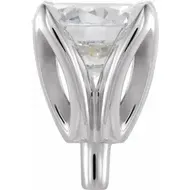Some jewellers will offer their clients a thin 4-claw setting instead of a 6-claw setting for a 1-carat diamond.
My objective in making a ring is always in 'security'. If claws are gently pushed aside or become loose in a 4-claw setting, thousands of dollars can be quickly LOST!
This STRONG 4-claw head will hold any size of diamond without any 'security' problems. Some of the claw settings that are shown here are stamped, but not cast.
The best and most basic style with 'absolute 100% security' in a 4-claw shape is shown here.
For those clients who wish a 'bit of flair', here is an 8-claw setting with Triangular diamonds.
My number one choice is a sturdy 6-claw setting that will easily accommodate a 1/2 carat diamond.
This particular ring will accommodate a diamond of 1 carat in size. The 4 claws should always be vertical, but never slanted. The Culet Facet of every gemstone should be in the centre of the head.
I'm using an "Inside, ring clamp" that will allow me to trim all of the claws without damaging them in the process.
If you wish to set 3 diamonds (or coloured gemstones) on each side in a Flush stone configuration, you have that extra option.
THESE PHOTOS SHOW THE VARIETY OF HEADS.
(REMEMBER TO POLISH THE CLAW SETTINGS BEFORE ANY GEMSTONE IS TO BE SET.)
'Double-claws' are one of the best in dealing with security and long-lasting beauty.
These thick claws literally hold the diamond or expensive gemstone without any adverse problems. I'd use these strong claws with no second thought.
This style of claw-setting is named "Tulip" as it appears to look like a flower arrangement. The 'tips of the flower' are actually claws in disguise without the usual 4-claw configuration.
The 'basket' is basically a wonderful-looking design that gives the wearer much pleasure.
These 4 claws blend with the 'Crown Facets'. Although these claws are wide, but are so very strong. The curved tips are 'rounded' for a purpose, as they seem almost invisible from the top.
As this is a yellow creation, this 'basket' looks like a flower.
This final choice of a setting is for a diamond of a 3/4 carat size, but refrain from anything larger. The reason is that the diamond might appear to be 'top-heavy' to the thin-looking shank.
These 4 claws blend with the 'Crown Facets'. Although these claws are wide, but are so very strong. The curved tips are 'rounded' for a purpose, as they seem almost invisible from the top.
This final choice of a setting is for a diamond of a 3/4 carat size, but refrain from anything larger. The reason is that the diamond might appear to be 'top-heavy' to the thin-looking shank.

%20(1).jpg)
.jpg)
.jpg)

.jpg)







